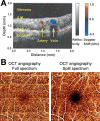Optical Coherence Tomography Angiography
- PMID: 27409483
- PMCID: PMC4968919
- DOI: 10.1167/iovs.15-19043
Optical Coherence Tomography Angiography
Abstract
Optical coherence tomography angiography (OCTA) is a noninvasive approach that can visualize blood vessels down to the capillary level. With the advent of high-speed OCT and efficient algorithms, practical OCTA of ocular circulation is now available to ophthalmologists. Clinical investigations that used OCTA have increased exponentially in the past few years. This review will cover the history of OCTA and survey its most important clinical applications. The salient problems in the interpretation and analysis of OCTA are described, and recent advances are highlighted.
Figures





References
-
- Drexler W,, Liu M,, Kumar A,, Kamali T,, Unterhuber A,, Leitgeb RA. Optical coherence tomography today: speed, contrast, and multimodality. J Biomed Opt. 2014; 19: 071412. - PubMed
-
- Hope-Ross M,, Yannuzzi LA,, Gragoudas ES,, et al. Adverse reactions due to indocyanine green. Ophthalmology. 1994; 101: 529–533. - PubMed
-
- Lopez-Saez MP,, Ordoqui E,, Tornero P,, et al. Fluorescein-induced allergic reaction. Ann Allergy Asthma Immunol. 1998; 81: 428–430. - PubMed
Publication types
MeSH terms
Grants and funding
LinkOut - more resources
Full Text Sources
Other Literature Sources
Miscellaneous

